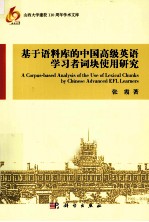图书介绍
基于语料库的中国高级英语学习者词块使用研究PDF|Epub|txt|kindle电子书版本下载

- 张霞编 著
- 出版社: 北京:科学出版社
- ISBN:9787030339782
- 出版时间:2012
- 标注页数:199页
- 文件大小:69MB
- 文件页数:218页
- 主题词:英语-学习方法-研究-中国
PDF下载
下载说明
基于语料库的中国高级英语学习者词块使用研究PDF格式电子书版下载
下载的文件为RAR压缩包。需要使用解压软件进行解压得到PDF格式图书。建议使用BT下载工具Free Download Manager进行下载,简称FDM(免费,没有广告,支持多平台)。本站资源全部打包为BT种子。所以需要使用专业的BT下载软件进行下载。如BitComet qBittorrent uTorrent等BT下载工具。迅雷目前由于本站不是热门资源。不推荐使用!后期资源热门了。安装了迅雷也可以迅雷进行下载!
(文件页数 要大于 标注页数,上中下等多册电子书除外)
注意:本站所有压缩包均有解压码: 点击下载压缩包解压工具
图书目录
Introduction1
Chapter 1 Lexical Chunks and Language Description6
1.1 The conventional use of language as a long-standing and long-recognized phenomenon6
1.1.1 A de facto,long-standing and wide-spread phenomenon6
1.1.2 A long recognized phenomenon9
1.2 The centralization of conventional language in neo-Firthian researches12
1.2.1 The difference between the functionalist and mentalist paradigms12
1.2.2 From meaning and function to the conventional use of language14
1.2.3 How neo-Firthian arguments solve the problem of productivity19
1.3 Lexical chunks as representing conventionality in language use21
1.3.1 The nature of lexical churks21
1.3.2 Features of lexical chunks22
1.4 A review of the methodology development in studies of lexical chunks30
1.4.1 The marginalization of phraseology and the salience approach31
1.4.2 The centralization of phraseology and the statistical approach32
1.4.3 Altenberg,Biber and the study of lexical chunks35
1.5 Summary37
Chapter 2 Lexical Chunks and Language Acquisition39
2.1 A comparison39
2.2 Holistic language processing and FLA40
2.2.1 Explanatory adequacy and the alternative expediency41
2.2.2 Holistic language processing and the route of FLA42
2.2.3 The role of holistic language processing in FLA44
2.3 Lexical chunks and SLA45
2.3.1 Differences and similarities between advanced EFL learners and first language acquiring children46
2.3.2 Lexical chunks and the route of SLA47
2.3.3 Lexical chunks and the success of SLA-the social-functional level48
2.3.4 Lexical chunks and the success of SLA-the lexico-grammatical level50
2.3.5 Lexical chunks and the success of SLA-extant studies51
2.4 Procedural vocabulary and lexical chunks53
2.4.1 The conception of procedural vocabulary53
2.4.2 The relationship between procedural vocabulary and lexical chunk55
2.5 Deviations in learners'use of lexical chunks-description and diagnosis57
2.5.1 Two kinds of deviations and two approaches to the diagnosis58
2.5.2 The CIA approach and the diagnosis of learner deviations59
2.5.3 The research questions of the present research61
2.6 The acquisition of lexical chunks in the classroom context63
2.7 Summary66
Chapter 3 The Methodology68
3.1 An NLP perspective of the study of lexical chunks68
3.1.1 Hybrid algorithms69
3.1.2 Association measures71
3.1.3 Statistical algorithms to decide MWU boundary73
3.1.4 Dispersion75
3.1.5 The extraction of procedural vocabulary76
3.1.6 The automatic extraction of patterns around a certain word78
3.2 The methodology of the present study79
3.2.1 Corpora used-size,sampling and preprocessing79
3.2.2 The extraction of lexical chunks:length range,frequency,dispersion and boundary determination81
3.2.3 The filtering process84
3.2.4 Tools of lexical chunk extraction85
3.2.5 Annotation86
3.2.6 The extraction of PV88
3.2.7 Word-form based lexical chunks and POS-tag sequences around PV90
3.3 The research design of the present study93
Chapter 4 Word-form Based Lexical Chunks95
4.1 The proportion issue95
4.2 Types and tokens of lexical chunks in different length categories96
4.3 Types,tokens and type/token ratio of lexical chunks in different corpora98
4.4 The structure and function characteristics of lexical chunks101
4.4.1 Dependent clause107
4.4.2 Independent clause110
4.4.3 Single clause constituent111
4.4.4 Incomplete phrase112
4.4.5 Multiple clause constituents113
4.4.6 The interaction between function and corpus123
4.5 Discussion and summary126
Appendix:Complementary statistical analyses127
Chapter 5 POS-tag Sequences Around PV131
5.1 Procedural words in the four corpora131
5.1.1 Rank correlation analysis131
5.1.2 Distribution of content and function words135
5.1.3 Distribution of PV of various parts of speech137
5.2 The relationship between procedural words and lexical chunks140
5.2.1 The proof of the close relationship between PV and lexical chunks140
5.2.2 Descriptive statistics144
5.3 procedural words common to the corpora under study146
5.3.1 Analysis of take147
5.3.2 Analysis of make156
5.3.3 Analysis of time and way163
5.4 Summary168
Appendix:Complementary statistical analysis169
Chapter 6 Major Findings Revisited173
6.1 Major findings and conclusions173
6.2 Limitations and prospects175
6.2.1 Higher degree of abstractness175
6.2.2 Semantic prosody and discoursal functions176
6.2.3 The developmental dimension177
6.2.4 Procedural vocabulary178
References180
Appendix191